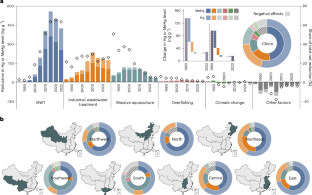China’s municipal wastewater policies enhanced seafood safety and offset health risks from atmospheric mercury emissions in the past four decades
IF 21.9
Q1 FOOD SCIENCE & TECHNOLOGY
引用次数: 0
Abstract
The neurotoxin methylmercury in seafood threatens food safety worldwide. China has implemented stringent wastewater policies, established numerous treatment facilities and enforced rigorous water quality standards to address pollution in its waterways. However, the impact of these policies on seafood safety and methylmercury exposure remains unknown. Here we developed a process-based model showing that, although mercury reductions from municipal wastewater policies accounted for only 9% of atmospheric mercury emissions during 1980–2022, these measures unexpectedly prevented $${\mathrm{102,000}}_{-\mathrm{6,600}}^{+\mathrm{11,000}}$$ mercury-related deaths and counteracted nearly two thirds of potential deaths from those emissions. Furthermore, these policies ensured that $${146}_{-9}^{+8}$$ megatonnes of freshwater seafood met the World Health Organization and China’s mercury-safety standards, preventing $${\mathrm{US}}\${498}_{-29}^{+32}$$ billion in economic losses. Finally, we explore how China, as the primary global seafood producer and exporter, could develop municipal wastewater policies at the regional level to reduce aquatic pollutants and unlock the health benefits of seafood consumption. Seafood methylmercury contamination is a global food safety issue. A model is developed to explore the impact of China’s municipal wastewater policies on seafood safety and reductions in methylmercury exposure.


在过去的40年里,中国的城市污水处理政策提高了海产品的安全性,抵消了大气汞排放带来的健康风险
海产品中的神经毒素甲基汞威胁着全世界的食品安全。中国实施了严格的废水处理政策,建立了大量的处理设施,并实施了严格的水质标准,以解决水道污染问题。然而,这些政策对海产品安全和甲基汞暴露的影响仍然未知。在这里,我们开发了一个基于过程的模型,该模型显示,尽管城市废水政策的汞减排仅占9%% of atmospheric mercury emissions during 1980–2022, these measures unexpectedly prevented \({\mathrm{102,000}}_{-\mathrm{6,600}}^{+\mathrm{11,000}}\) mercury-related deaths and counteracted nearly two thirds of potential deaths from those emissions. Furthermore, these policies ensured that \({146}_{-9}^{+8}\) megatonnes of freshwater seafood met the World Health Organization and China’s mercury-safety standards, preventing \({\mathrm{US}}\${498}_{-29}^{+32}\) billion in economic losses. Finally, we explore how China, as the primary global seafood producer and exporter, could develop municipal wastewater policies at the regional level to reduce aquatic pollutants and unlock the health benefits of seafood consumption.
本文章由计算机程序翻译,如有差异,请以英文原文为准。
求助全文
约1分钟内获得全文
求助全文

 求助内容:
求助内容: 应助结果提醒方式:
应助结果提醒方式:


